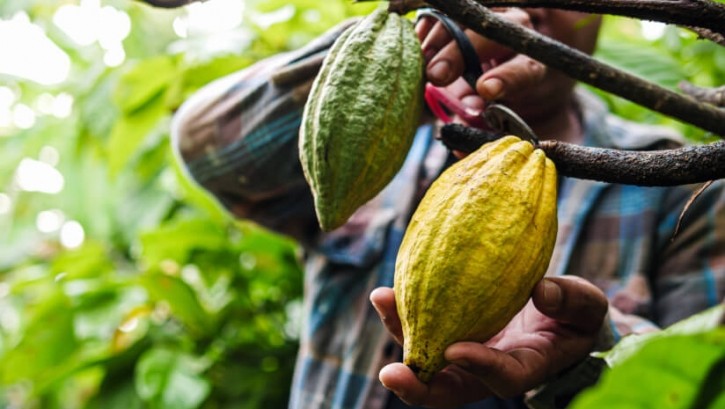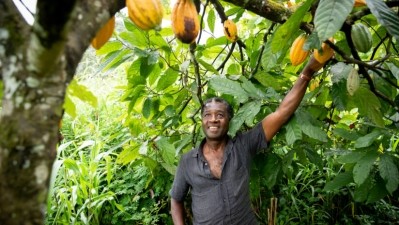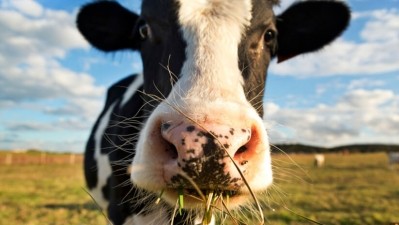Hershey says it’s not satisfied with efforts to support cocoa farmers

Earlier this year, Hershey made its first round of payments to farmers participating in its Income Accelerator Programme (IAP), paying 1,426 farming households the first wave of top-up payment.
The program, launched in April 2023 in Cote d’Ivoire, provides farming families with supplemental income and incentivizes the adoption of sustainable agricultural practices.
The five-year plan sets out to help 20,000 households with a $40m investment, and was developed in response to the need to build holistic economic resilience in supply chains within the cocoa industry. “We were not satisfied with the pace of change, so we have altered our approach to go further and faster to address these systemic challenges through the creation of the Hershey Income Accelerator Program.”
Poverty reduction strategies are at the HIAP’s core, aiming to address various needs, including teaching skills such as financial literacy, joint decision-making, farm productivity and diversification investments, and access to affordable finance. “It takes an environment of supportive practices and broad cooperation to tackle the complex issues facing the industry,” Hershey’s spokesperson added.
A $40 million cocoa-support programme
Hershey collaborated with Côte d’Ivoire’s national governing body for cocoa, the Conseil du Café-Cacao, along with its partners: CARE International, Rainforest Alliance (RA) and PUR and a cohort of five farming families on the ground to develop the program.
Recognizing farmers’ critical role in its supply chain, growing what it describes as its “most important ingredient”, Hershey’s strategy aims to increase cocoa farming households’ income by 20% through cash transfers made on top of the price set by local governments.
Hershey’s IAP: The first 12 months
In its first year, the company says its focus has been on developing a new approach to working with farmers and has onboarded 1,850 so far. Of these, some 1,426 have received their first cash transfers directly to their mobile money accounts.
Farmers participating in the HIAP will receive two additional cash transfers in 2024. The first payment to agricultural families will be made at the start of the academic year, with the aim to support farmers to pay for schooling and other education costs for their children. The second payment towards the end of 2024 is designed to help farmers adopt sustainable farming techniques that result in more fruitful, resilient crops and long-term enhancements.
IAPs: A new way to support cocoa-farming communities
The global chocolate company launched its HIAP a year after Nestlé became the first multinational chocolate company to announce its own plans to help farmers protect their incomes.
For both of these chocolate titans, the launch of their respective IAPs has come as the cocoa sector struggles with escalating and volatile raw material prices and severe crop disruption. The cocoa crisis, now in its third season, was prompted by the climatic El Niño phenomenon, pests, and diseases.
Together, these factors have contributed to ravaged crops and reduced farmer production output by 10.9% to an expected 4.45 million metric tonnes this season, the International Cocoa Organisation (ICCO) predicted in March 2024.
Ensuring farmers earn a livable income has been a contentious topic for years. Now, with cocoa in crisis, farmers face more instability and increased risks of poverty. IAPs have emerged to limit the impact of crop shortages on their livelihoods.
Closing the income gap for farmers helps them better manage the costs of running a cocoa farm and support their families. Providing financial support also enables them to adopt environmentally sustainable agricultural methods, like revitalising existing farms instead of seeking new ones. For example, farmers might be inclined to invest in cocoa crops grown in the shade, which helps support biodiversity and can lead to higher yields.
Nestlé recognizes Hershey’s IAP
Nestlé’s IAP was launched in January 2022, but the firm is happy that other rivals are following its lead. “It’s been encouraging to see Hershey launching their income accelerator to enhance the wellbeing of cocoa farming families,” said a Nestlé spokesperson. “We are delighted to see the commonality within our approach,” Nestlé’s spokesperson adds. The company hopes to see more stakeholders and industry players take action and join its efforts to make a difference at the sector level.
“We’re applying what we’ve learned from years of programming in cocoa-farming communities and engaging with leading child rights advocates,” a representative for Hershey added. “Realising our vision of a resilient supply chain where farmers and their families can prosper means prioritising economic resilience by increasing income and working with our partners to improve the lives of the whole family.”
Nestlé and Hershey's IAPs in numbers
















